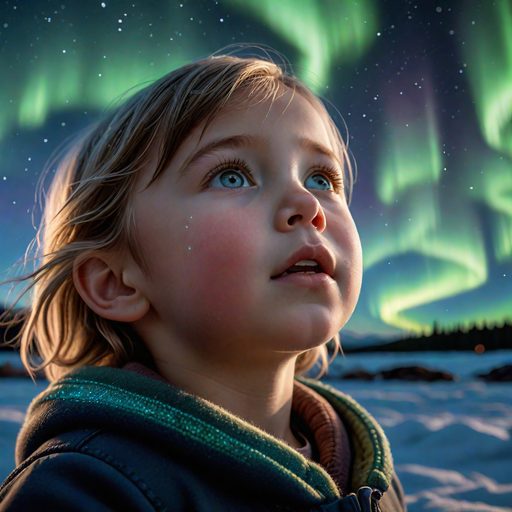
Aurora Lights to Peak as Sun Enters Solar Maximum
Recommended for Middle Grades
Prepare to be captivated by the aurora borealis and aurora australis, nature’s most dazzling light shows. As our Sun reaches the peak of its activity cycle, these celestial wonders will become more frequent and intense, painting the night sky with breathtaking hues of green, red, blue, and purple.
But the auroras are more than just a visual spectacle—they are a testament to the sun’s immense power and its complex relationship with Earth.
Join us as we delve into the science behind these mesmerizing lights, explore the potential impact of solar storms on our technology, and marvel at the sheer beauty of this celestial dance.
Aurora Lights: A Celestial Symphony Conducted by the Sun
The Sun’s Crescendo: When Solar Activity Peaks
Imagine the sun as a grand orchestra, its instruments composed of magnetic fields and charged particles. As the sun’s activity reaches its crescendo, a symphony of light and energy erupts, cascading towards Earth.
This solar maximum, a peak in the sun’s 11-year cycle, amplifies the aurora borealis and aurora australis, transforming the night sky into a breathtaking canvas of dancing colors.
But the aurora lights are more than just a dazzling spectacle. They are a tangible manifestation of the sun’s immense power and its complex relationship with our planet. The solar flares and coronal mass ejections that fuel the auroras also have the potential to disrupt our technology, impacting power grids and satellites.
Understanding this celestial ballet is crucial for appreciating both its beauty and its potential consequences.
The aurora lights are born from a cosmic dance between charged particles from the sun and Earth’s magnetic field. Like a magnetic highway, Earth’s field guides these particles towards the poles, where they collide with atmospheric gases.
This collision releases energy in the form of light, creating the mesmerizing hues of the auroras.
Auroras: A Kaleidoscope of Colors
The colors of the auroras are determined by the types of atmospheric gases involved in the collision. Oxygen molecules produce green and red light, while nitrogen molecules emit blue and purple hues.
The result is a kaleidoscope of colors that shimmers and dances across the sky.
Typically, the auroras are confined to high latitudes near the Arctic and Antarctic circles. However, during periods of heightened solar activity, like the recent solar storm, the auroras can extend further south (or north in the southern hemisphere), treating a wider audience to their ethereal beauty.
Witnessing the aurora borealis or aurora australis is a truly unforgettable experience. It’s a reminder of our connection to the cosmos, a testament to the power and beauty of the natural world.
Whether you’re a seasoned aurora chaser or a first-time observer, the sight of these dancing lights is sure to leave you in awe.
The Hidden Power of the Auroras
The aurora lights are not just a visual feast; they are also a powerful electromagnetic phenomenon. The same energy that creates the auroras can also induce electrical currents in power lines, pipelines, and other infrastructure.
These geomagnetic storms, while rare, can cause significant damage and disruption to our technological systems.
Scientists and engineers are constantly working to better understand and mitigate the risks posed by geomagnetic storms. By developing early warning systems and protective measures, we can safeguard our power grids, satellites, and other critical infrastructure from the sun’s powerful outbursts.
The aurora lights are a beautiful and awe-inspiring phenomenon, but they also serve as a reminder of our planet’s vulnerability to the forces of space weather.
As we become increasingly reliant on technology, it is essential to understand and respect the power of the sun and its impact on our world.
Watch a video
Feast your eyes on this stunning footage of the Aurora Borealis in action!
Curious Times is a leading newspaper and website for kids. We publish daily global news aligned to your learning levels (also as per NEP 2020): Foundational, Preparatory (Primary), Middle and Senior. So, check out the News tab for this. We bring kids’ favourite Curious Times Weekly newspaper every weekend with top news, feature stories and kids’ contributions. Also, check out daily JokesPoke, Tongue Twisters, Word of the Day and Quote of the Day, kids need it all the time.
Curious Times News Program for Schools for FREE. Over 5,000 schools and teachers from all over the world have joined our programme so that students and teachers can get FREE Educative Newspaper. Here, kids can take part in world events and win prizes and certificates for free through their schools.
Moreover, schools are sharing important School News, like interviews with the principal, notices about new students, contests, and results, not just on social media but also on a news website for kids and other schools.
Thus, do not wait any further, sign-up for your school for FREE.
The following social media platforms allow you to communicate with us: WhatsApp, Instagram, Facebook, Youtube, Twitter, and LinkedIn.
0 (Please login to give a Curious Clap to your friend.)
